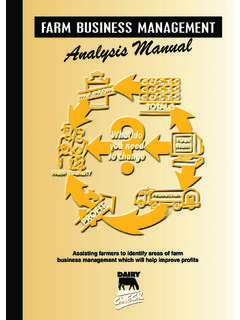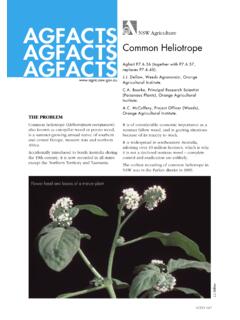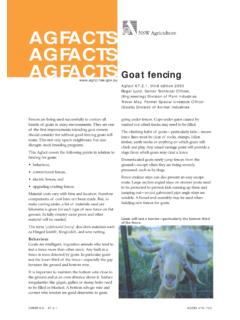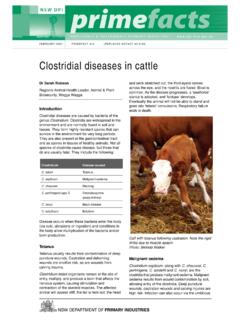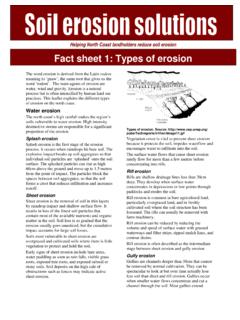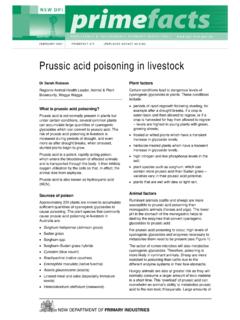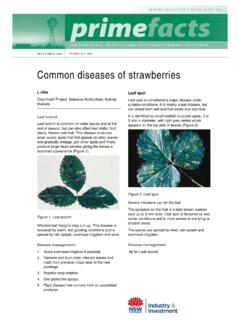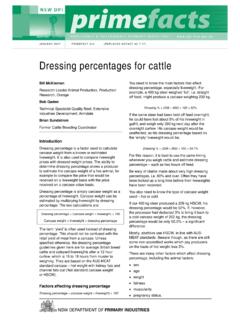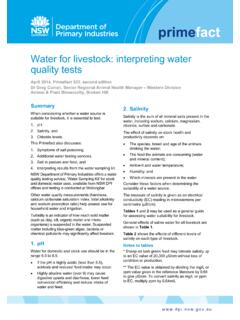Transcription of Fireweed - dpi.nsw.gov.au
1 PRIMEFACT Fireweed Invasive Species Unit Fireweed (Senecio madagascariensis) is a highly invasive and opportunistic weed native to south-eastern Africa. It quickly colonises overgrazed pastures and disturbed areas (Figure 1). Impacts Fireweed is a serious pasture weed of coastal New South Wales (NSW). It is able to grow on most soil types and in all aspects. It forms a persistent seedbank if not controlled before it flowers and can rapidly take over heavily grazed and neglected pastures, competing strongly with existing pasture plants. It seeds prolifically and grows to maturity quickly.
2 Density is influenced by groundcover and competition, especially in autumn. Fireweed can quickly establish: where ground has been cultivated or disturbed, or where groundcover competition is reduced (Figure 8), for example in drought, or under excessive grazing pressure. The population of Fireweed in infested areas depends on seasonal conditions and varies from year to year. Fireweed infestations may: reduce the total grazing capacity of a property; decrease pasture production; decrease livestock growth rates; and incur high control costs.
3 identification Fireweed is a daisy-like plant that grows from 10 to 60 cm high (Figure 2). It has a variable growth habit and leaf structure, but the most common form of Fireweed is a low, heavily branched, annual or short-lived perennial plant. Leaves Generally bright green in colour, fleshy and narrow, leaves are 2 7 cm long, alternately arranged on the stem, and have serrated, entire or lobed margins (Figure 4). Broader leaves usually clasp around the stem. Figure 1. Fireweed is an invasive weed of pastures along coastal NSW. Photo: N Griffiths Reprinted May 2012 for updates Invasive Species Unit, Biosecurity NSW Flowers Small, yellow and daisy-like, flowers are 1 2 cm in diameter and arranged in clusters at the end of each branch.
4 They can number from 0 to 200 per plant, and each flower will commonly have 13 petals and 21 bracts forming the cup under the flower (Figures 3 and 5). Seeds Seeds are small (1 3 mm long), light and slender. They are cylindrical in shape and have a downy surface. They are attached to a pappus, consisting of fine, silky, white feathery hairs that aid in dispersal by wind. Roots Fireweed has a shallow, branched taproot with numerous fibrous roots growing from 10 to 20 cm deep. Distribution and habitat Fireweed is largely restricted to the south-eastern coast of Australia and has established along the Figure 2.
5 Fireweed is a heavily branched daisy-like plant. Photo H Rose. Figure 3. The 21 light green petal-like structures (phyllaries) that form the cup under the flower distinguish Fireweed from other closely related species. Photo: B Johnston. entire NSW coast. First recorded in the Hunter Valley in 1918, it has spread south into Victoria and occurs as far north as central Queensland. It also occurs on the northern and southern tablelands of NSW and as isolated infestations in parts of inland NSW. While Fireweed does occur on the southern tablelands and inland NSW, it is likely to be less invasive in these areas.
6 It grows on a wide range of soil types, from high fertility, self-mulching clay soils to low fertility, acid, sandy soils. It is most prolific in well-drained, lighter-textured, acid soils of low to medium fertility. It will not survive in poorly drained or waterlogged situations. Figure 4. The serrated leaf margins of Fireweed . Photo: H Rose Figure 5. The small flower of Fireweed usually has 13 petals. Photo: H Rose p 2 Fireweed Fireweed does not grow well in shaded areas, preferring open country and areas of bare soil. It will quickly invade roadsides, pastures and open forests, and heavy infestations are common on cultivated or disturbed land.
7 A native plant with several subspecies of differing appearance (Senecio pinnatifolius), also known as variable groundsel, is sometimes confused with Fireweed . More widely distributed throughout alpine, arid and coastal environments, it occurs in a range of climatic and geographical regions throughout Australia, except in the far northern areas, and is not considered a weed. S pinnatifolius is mainly found in locations where the pest variety of Fireweed is unlikely to grow, such as woodlands, bushland and undisturbed sites. Lifecycle Fireweed is opportunistic and able to take advantage of changes in the environment.
8 Under favourable seasonal conditions, the plant may behave as a short-lived perennial, with some plants surviving for 3 years. However, the majority of plants only live for one season. On the coastal strip of NSW Fireweed is capable of germinating, growing and flowering during most of the year. Most stages of the plant (seedlings to flowering) can be seen at almost any time of the year. However, most seeds germinate in autumn. Germination depends on a combination of rainfall, light and temperature. Rainfall when the temperature is 15 27 C will produce flushes of new seedlings.
9 Seeds are less likely to germinate if they are buried more than 2 cm below the soil surface. However, some buried seed may remain viable in the soil for up to ten years. Once released from the flower head, many seeds can germinate immediately, and then several Figure 6. Fireweed seedlings germinate in flushes in response to significant rainfall events in autumn. These seedlings in a kikuyu pasture have produced their first pair of leaves. Photo: B Johnston. germinations can occur in one season if conditions are favourable. Plants grow quickly and can produce flowers 6 10 weeks after emergence, with flowering occurring mainly in spring.
10 Fireweed seeds profusely, with each flower producing between 50 and 120 seeds of high viability. One plant is capable of producing 5 000 to 30 000 seeds in one season depending on conditions. Most seed germinates quickly, but about 15% of seed has a high level of dormancy. Fireweed usually begins to die off in the spring. However, in some plants, only the top of the plant dies back, leaving the base and roots intact over the summer. The plant may then quickly regrow from the crown the following autumn. Spread The light fluffy seeds of Fireweed are easily spread by wind.
